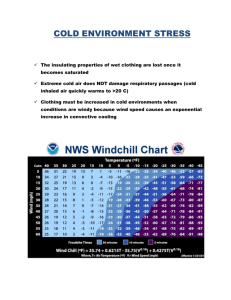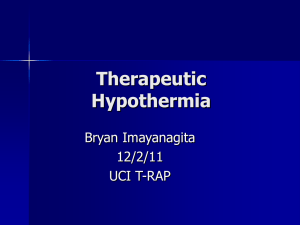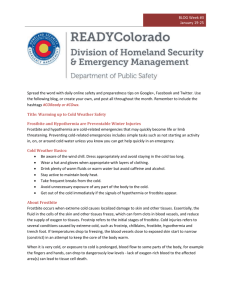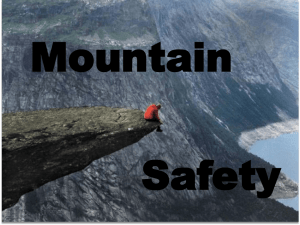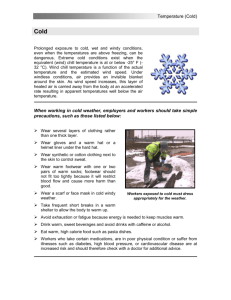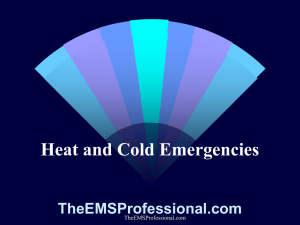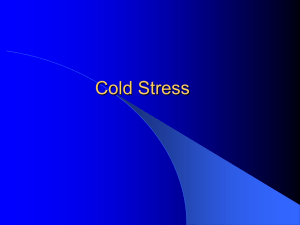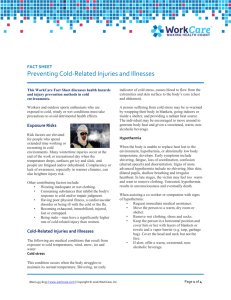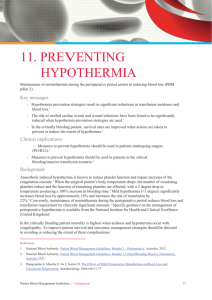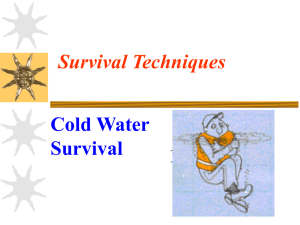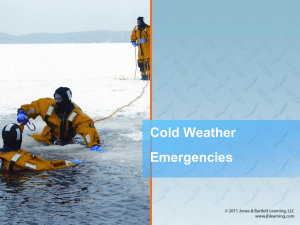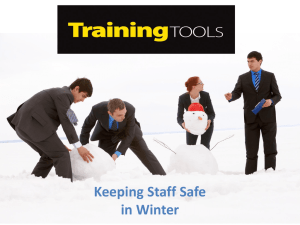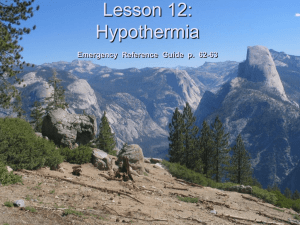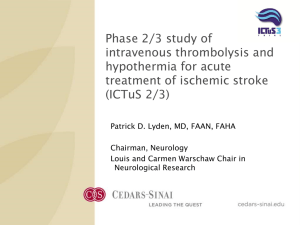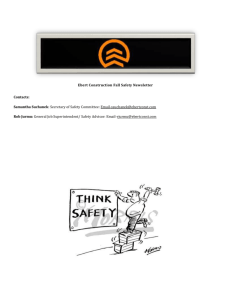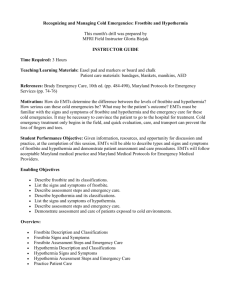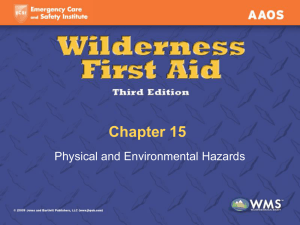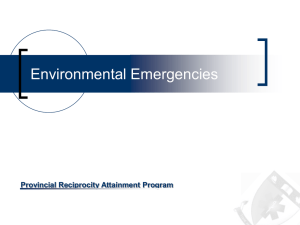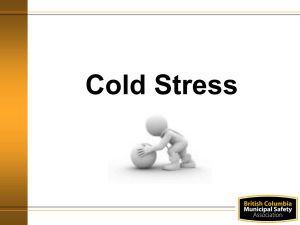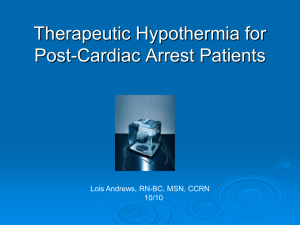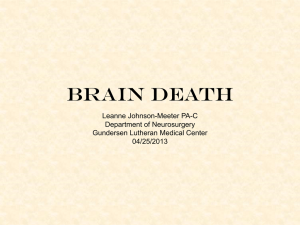Cold Stress
advertisement
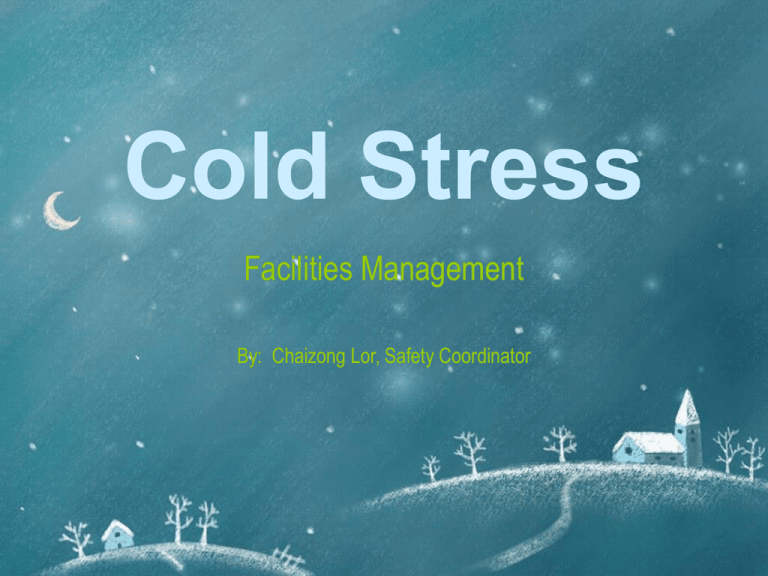
Cold Stress Facilities Management By: Chaizong Lor, Safety Coordinator Objectives • • • • • • • • Cold Stress Factors Cold Environment Basic Hypothermia Concepts Conditions Affecting Hypothermia Hypothermia Signs & Symptoms Safety Procedures Frostbite Preventing Cold Stress Cold Stress Factors • Cold stress is the loss heat to the environment due to: – Low temperature: Cold air temperatures • The Cold will forces body to work harder to maintain it’s temperature • The Cold air, water, and snow all draw heat from the body – Wind: High velocity air movement • Wind chill is combination of air temperature and wind speed and capable of bringing cold stress in the 50’s with rain and wind – Wetness: Contact with cold water or surfaces • The body’s first response to cold stress is to conserve body heat by reducing blood circulation through the skin. Cold Stress Factors • Normal body temperature is 98.6 degrees F. • When body temperature drops below 86 degree F, the temperature control system becomes ineffective. • When body temperature drops below 59 degrees F, it begins to experience impairment of many functions. Basic Hypothermia Concepts • Hypothermia means “Low Heat” and is a potentially serious health condition • The major injuries associated with cold temperatures are: – General hypothermia – Immersion hypothermia – Frostbite • Prolonged exposure to cold causes the body to lose energy faster than it is produced Conditions Affecting Hypothermia • Aging, allergies, poor circulation & illness • Self-imposed conditions, such as alcohol use, anti-depressants, or sedatives – The body may have difficulty regulating temperature. • Wet clothing, windy conditions, & poor physical condition Hypothermia Signs & Symptoms • Increased Risk – Predisposing Health Conditions • Cardiovascular Disease • Diabetes • Hypertension – Poor Physical Condition Hypothermia Signs & Symptoms • Mild Hypothermia (98 – 90 degrees F) – Shivering – Numbness in limbs, loss of dexterity, and clumsiness – Slurred speech – Memory loss – Pale, cold skin Hypothermia Signs & Symptoms • Moderate Hypothermia (90 – 86 degrees F) – Shivering stops – Confused and irrational – Unable to walk or stand • Severe Hypothermia (86 – 78 degree F) – Severe muscle stiffness – Very sleepy or unconscious – Ice cold skin – Reduced pulse – Death is a possibility Safety Procedures • Proper treatment depends on the severity of the hypothermia – Mild Hypothermia • Move to warm area • Stay active • Remove wet clothes and replace with dry clothes or blankets, cover the head • Drink warm (not hot) sugary drink Safety Procedures Cont. • Moderate Hypothermia – Use all of the Mild Hypothermia procedures and plus the following: • Call 911 for an ambulance • Cover all extremities completely • Warm center of body first with warm objects • Severe Hypothermia – Call 911 for an ambulance – Treat the victim very gently – Do not attempt to re-warm, the victim should receive treatment in a hospital Frostbite • Frostbite occurs when the skin actually freezes and loses water. • Freezing of deep layers of skin • Pale, waxy-white skin color • Skin becomes hard and numb • Usually affects: – Fingers and hands – Toes and feet – Ears and nose Frostbite Cont. • Three stages of frostbite – Frost nip • Individual experiences a “pins and needles” sensation and skin is unusually white and soft. – Superficial • Characterized by waxy feeling, frozen, numb, and possible blistering skin. – Deep • The most serious type of frostbite affects the blood vessels, muscles, nerves, tendons, and even bone -leading to possible permanent damage, blood clots, and death of body tissues. Emergency Procedures • What to do: – Call 9-911 – Move to warm area – Remove wet clothing – Drink warm sweet fluids – Do not rub the affected area – Wrap in soft cloth Preventing Cold Stress • Engineering Controls – Provide for general or spot heating, including hand warming. – Use insulating material on equipment handles. – Provide wind barriers if possible. • Administrative & Work Practices – Train employees about cold stress, cold-related disorders, and first aid. – Schedule work at warm times, if possible. – Move work to warm areas, if possible. – Take regular breaks in warm places. Preventing Cold Stress Cont. • Administrative & Work Practices Cont. – Use the buddy system (work in pairs when possible) – Drink warm, sweet fluids, avoid caffeine and alcohol – Recognize the environmental conditions that lead to cold stress • Personal Protection – Properly selected, insulated, and layered clothing – Waterproof boots and gloves – Eye protection for snow or ice-covered terrain Cold Stress Revision Dated: September 29th, 2014
